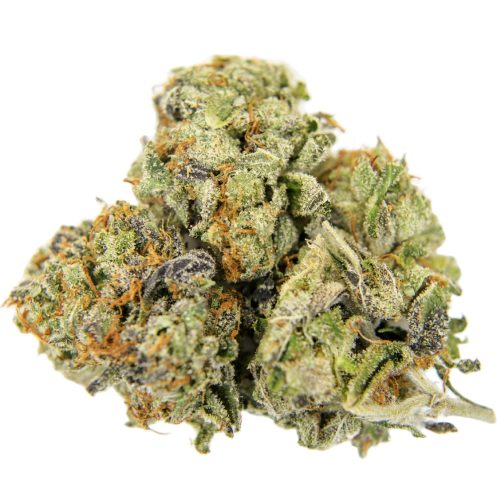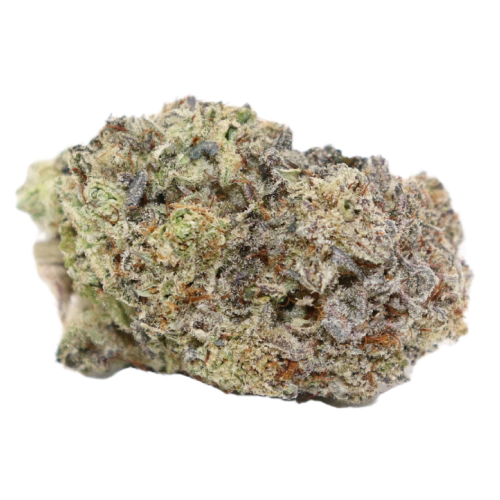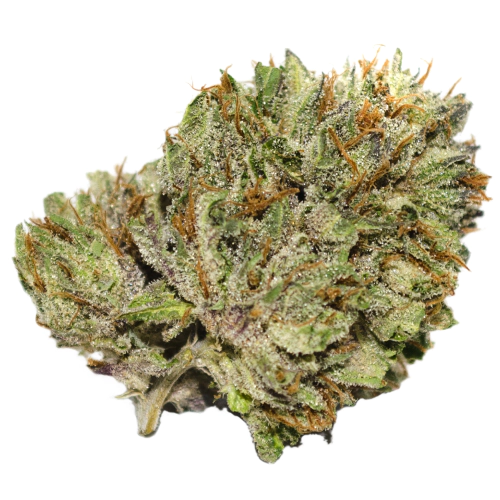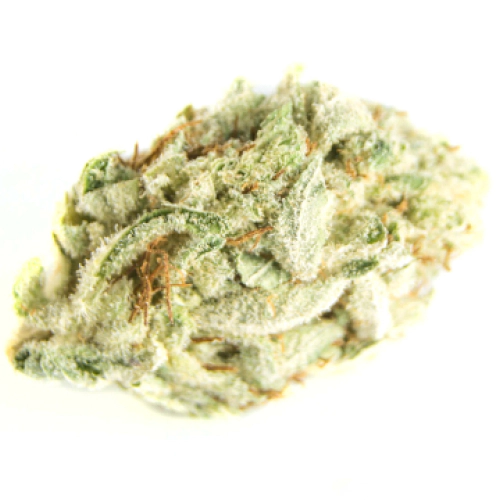THC 13.42 - 16.55%
CBD 0.34 - 0.96%
Effect Talkative
Flavor Honey
19 - 23%
0.62 - 0.76%
0.02 - 0.19%
Pineapple, Citrus
Hungry
Sitting Bull strain is a rare, evenly balanced hybrid (50% Sativa/50% Indica) bred by crossing the infamous Glass Slipper and Star Dawg strains. The weed produces a high effect that starts with a cerebral lift warming the mind with a sense of creativity, energy, and concentration. This cannabis bud has sweet and sour citrus with pineapple undertones and a light herbal exhale. The limonene and myrcene terpenes give the weed an earthy aroma with tropical fruits and citrus overtones. The THC concentration of Sitting Bull marijuana is high, varying from 19 - 23% in some species. Therefore, only veteran smokers should consume the strain, being well-prepared for its potent effect.
The chemical makeup of the Sitting Bull strain also consists of minor cannabinoids, including:
The Sitting Bull strain has a sweet aroma with sour pineapple citrus undertones and a delicate pine exhale. Dominated by limonene and myrcene, this weed flavor profile is complex and delicious. Every inhale starts with earthy tropical fruit taste and sour citrus hints, while on the exhale, users may notice a pungent taste with lime, apricot, and floral notes.
Terpene composition is also made up of the following:
The high produced by the Sitting Bull has a super story overtone physically, providing a stimulating cerebral effect on the mind. The weed may leave you feeling creative, talkative, and hungry. As your mind reaches new heights of energy and a clear mind, you can then experience a deeply calming and relieving high that will slowly overwhelm the body and up drop you into a completely couch-locked state that lasts for hours.
Thanks to these properties of the Sitting Bull marijuana flower, the bud is said to be perfect for treating medical patients suffering from:
Due to high THC levels and potent high sensation, sensitive consumers may experience some adverse effects like:
The Sitting Bull strain produces rounded, dense olive-green buds covered with bright orange hairs and a coating of frosty crystal trichomes. The flowering window of this marijuana flower is about 55 - 62 days, and growers can harvest the yield of 10 - 15 ounces per plant on day 59 after germination. Growing indoors, the weed reaches 30-60 Inches, while in outdoors condition 60-80 Inches.
| THC | Tetrahydrocannabinol, or THC, is a major cannabis chemical compound. It is a psychoactive element that stimulates dopamine release and induces euphoria or happiness. THC-rich strains may be helpful with such conditions as lack of appetite, chronic pains , etc. It is considered to be the primary active marijuana component. | 19 - 23% |
| CBD | Cannabidiol, or CBD, is a major compound in cannabis, which is non-psychoactive. It is also proved to counteract the side effects of the second major component THC. CBD is widely used for medicinal purposes in rubs, oils and so on. It is helpful in muscle pain cases, may treat arthritis and migraines. Even Greeks used it against pain, while Queen Victoria applied it to get rid of menstrual cramps. | 0.62 - 0.76% |
| CBC | Cannabichromene, or CBC, is a minor cannabinoid, meaning that its quantity in cannabis is quite little. Though it has the same origin as CBD and THC, it is different in functions. Without any psychoactive effects, it is an efficient cannabis compound in combating acne and depression. CBC produces analgesic, antibacterial and anti-inflammatory effects. | 0.18 - 0.19% |
| CBG | Cannabigerol, or CBG, is one of the minor cannabis compounds in adult plants. On the other hand, young ones contain a lot of this antibacterial and anti-inflammatory component. During the growth, CBG is converted into different cannabinoids, mostly THC and CBD. The compound itself increases appetite and decreases eye pressure. | 0.02 - 0.19% |
| CBN | Cannabinol, or CBN, is a trace element in cannabis that is considered to be mildly psychoactive. It appears from oxidation THC, exposed to light and heat. CBN is mostly contained in old cannabis and in traditional hashish. It is effective against insomnia, bacterial infections and appetite loss. | 0.04 - 0.18% |
| THCV | Tetrahydrocannabivarin, or THC-V, is a compound contained in cannabis in trace amounts. Even though it is close to THC molecularly, it is different in effects. This compound may be psychoactive only in large amounts. THC-V reduces blood sugar, controls appetite, stimulates bone growth, etc. African Sativa strains are the richest in THC-V. | 0.13 - 0.31% |
| Pinene | Pinene is one of the most widespread terpenes in nature, found in pine trees, basil, nutmeg, parsley, and rosemary. Cannabis containing terpene (alpha-pinene or α-pinene) boasts a strong pine scent. Pinene is responsible for anti-inflammatory, pain-relieving, and anti-anxiety effects. | 0.02% |
| Myrcene | Myrcene (also known as β-myrcene) is one of the most common terpenes found in cannabis, representing more than 20% of the modern marijuana terpene profile. Myrcene has a distinct earthy, musky flavor, resembling cloves. It is responsible for calming and soothing effects of weed. Myrcene is also found in hops, thyme, mango, lemongrass, guava melon. | 0.21% |
| Humulene | Humulene (also known as α-humulene) is one of the major terpenes found in cannabis, contributing to woody, earthy, spicy, herbaceous, and, mainly, floral aromas of cannabis. Used in modern medicine, humulene offers anti-inflammatory, antibacterial, and appetite suppressant effects, which have been well-researched by pharmaceutical companies. | 0.04% |
| Limonene | Limonene (also known as d-limonene) is the second most common terpene in nature and the third most common terpene in cannabis. It has a powerful citrus aroma and can be found in all citruses, including lemons, oranges, grapefruits, limes, juniper, etc. Limonene is known to elevate moods and provide anxiety, depression, and stress relief. | 0.29% |
| Linalool | Linalool (also known as beta linalool, linalyl alcohol, linaloyl oxide, and p-linalool) is one of the rarest terpenes found in cannabis, mostly in small quantities. Linalool is known for its spicy and lavender aroma, bringing relaxation and calming effects. It is also said to provide anti-inflammatory and analgesic properties that can be useful for athletes. | 0.13% |
| Valencene | Valencene is a terpene that got its name from Valencia oranges - a fruit where It's initially found. Valencene offers citrusy, sweet aromas, with flavors having notes of oranges, grapefruits, tangerines, and, occasionally, fresh herbs or freshly cut wood. Citrus aromas, frequently found in a wide variety of cannabis strains, are contributed to by valencene, which is known for anti-inflammatory and insect repelling properties. | 0.1% |
| Phellandrene | Phellandrene (also known as alpha- and beta-phellandrene) is one of the rare terpenes found in cannabis with antihyperalgesic and antidepressive properties. Phellandrene contributes to a minty, woody, and mildly citrus aroma in cannabis. Previously confused with limonene and pinene, phellandrene was eventually distinguished as a separate terpene common for eucalyptus. Also, it could be found in mint, dill, black pepper, cinnamon, parsley, pine, and lavender. | 0.06% |
| Caryophyllene | Caryophyllene (also known as beta or b caryophyllene) is a terpene found in many herbs and spices, such as black pepper, basil, rosemary, and oregano. Cannabis high in caryophyllene delivers a strong spicy, peppery aroma, resembling cinnamon and cloves. Caryophyllene offers potent anti-inflammatory and sedative effects. | 0.15% |
| Total terpenes content | 1.00% |
THC 13.42 - 16.55%
CBD 0.34 - 0.96%
Effect Talkative
Flavor Honey
THC 19.8 - 22.4%
CBD 0.43 - 0.68%
Effect Euphoric
Flavor Citrus

THC 21.17 - 23.17%
CBD 1.12 - 1.36%
Effect Happy
Flavor Diesel
THC 21.67 - 24%
CBD 0.36 - 0.69%
Effect Relaxed
Flavor Pine
THC 19.6 - 21.2%
CBD 0.35 - 0.57%
Effect Sleepy
Flavor Citrus
THC 16.5 - 22%
CBD 0.36 - 0.99%
Effect Giggly
Flavor Apple
THC 18.75 - 24.75%
CBD 0.06 - 1.9%
Effect Hungry
Flavor Chestnut
THC 13.5 - 17%
CBD 5.2 - 5.72%
Effect Uplifted
Flavor Diesel
THC 17 - 17%
CBD 0.55 - 0.84%
Effect Relaxed
Flavor Mango
THC 10.77 - 17.75%
CBD 0.46 - 1.35%
Effect Uplifted
Flavor Spicyherbal

THC 14.33 - 18%
CBD 0.19 - 0.74%
Effect Sleepy
Flavor Pine
THC 15 - 18%
CBD 1.03 - 1.27%
Effect Talkative
Flavor Strawberry
THC 14 - 22%
CBD 0.05 - 1.3%
Effect Sedated
Flavor Flowery

THC 1.25 - 2%
CBD 0.01 - 0.14%
Effect Hungry
Flavor Orange
THC 22 - 23%
CBD 0.29 - 0.42%
Effect Giggly
Flavor Spicyherbal

THC 10.98 - 17.42%
CBD 0.13 - 1.47%
Effect Uplifted
Flavor Flowery

THC 19 - 23%
CBD 0.13 - 0.29%
Effect Uplifted
Flavor Sweet
THC 10 - 12.5%
CBD 0.11 - 0.42%
Effect Euphoric
Flavor Earthy
THC 21.75 - 25%
CBD 0.5 - 0.88%
Effect Uplifted
Flavor Spicyherbal
THC 15.25 - 18%
CBD 0.54 - 0.74%
Effect Aroused
Flavor Chestnut
Be the first and share your opinion
Write a Review